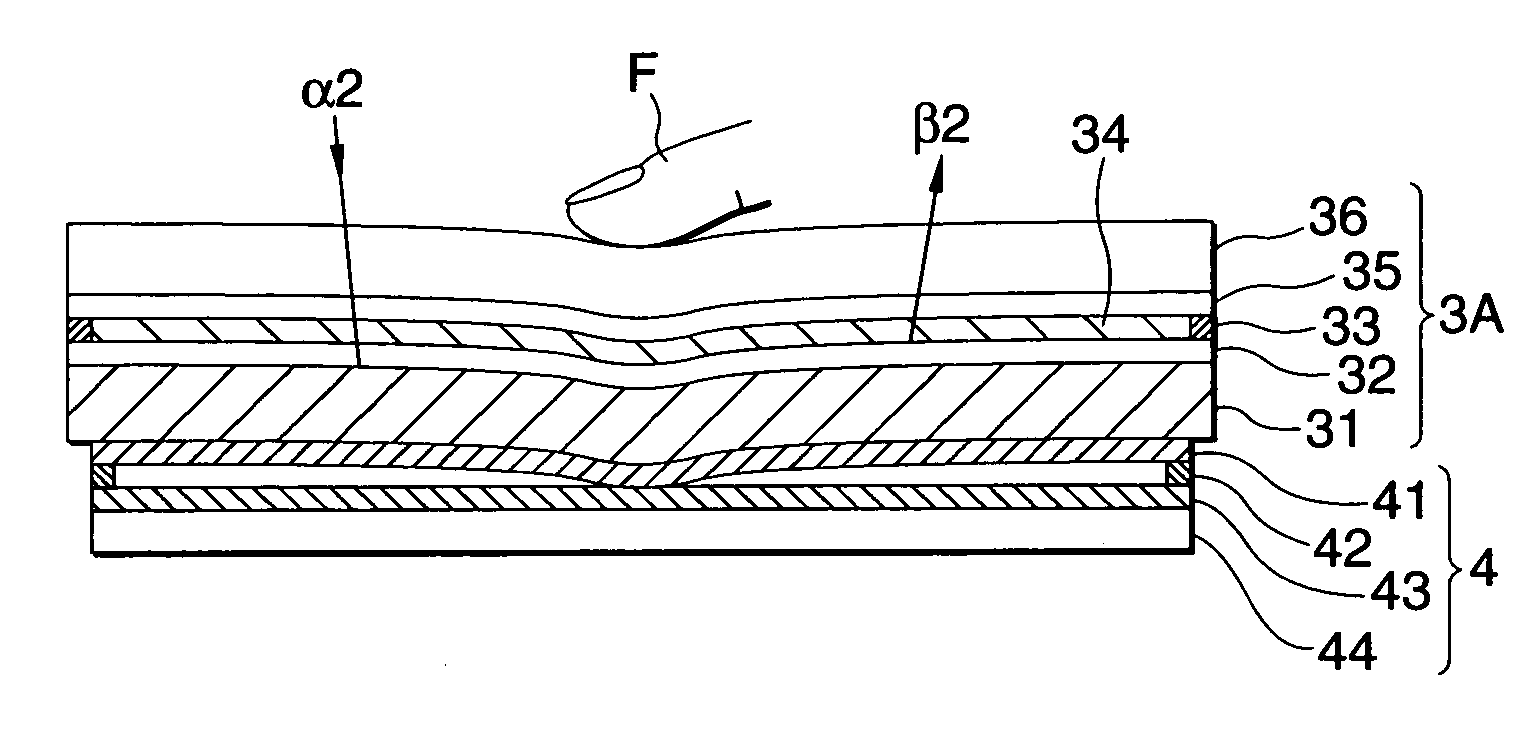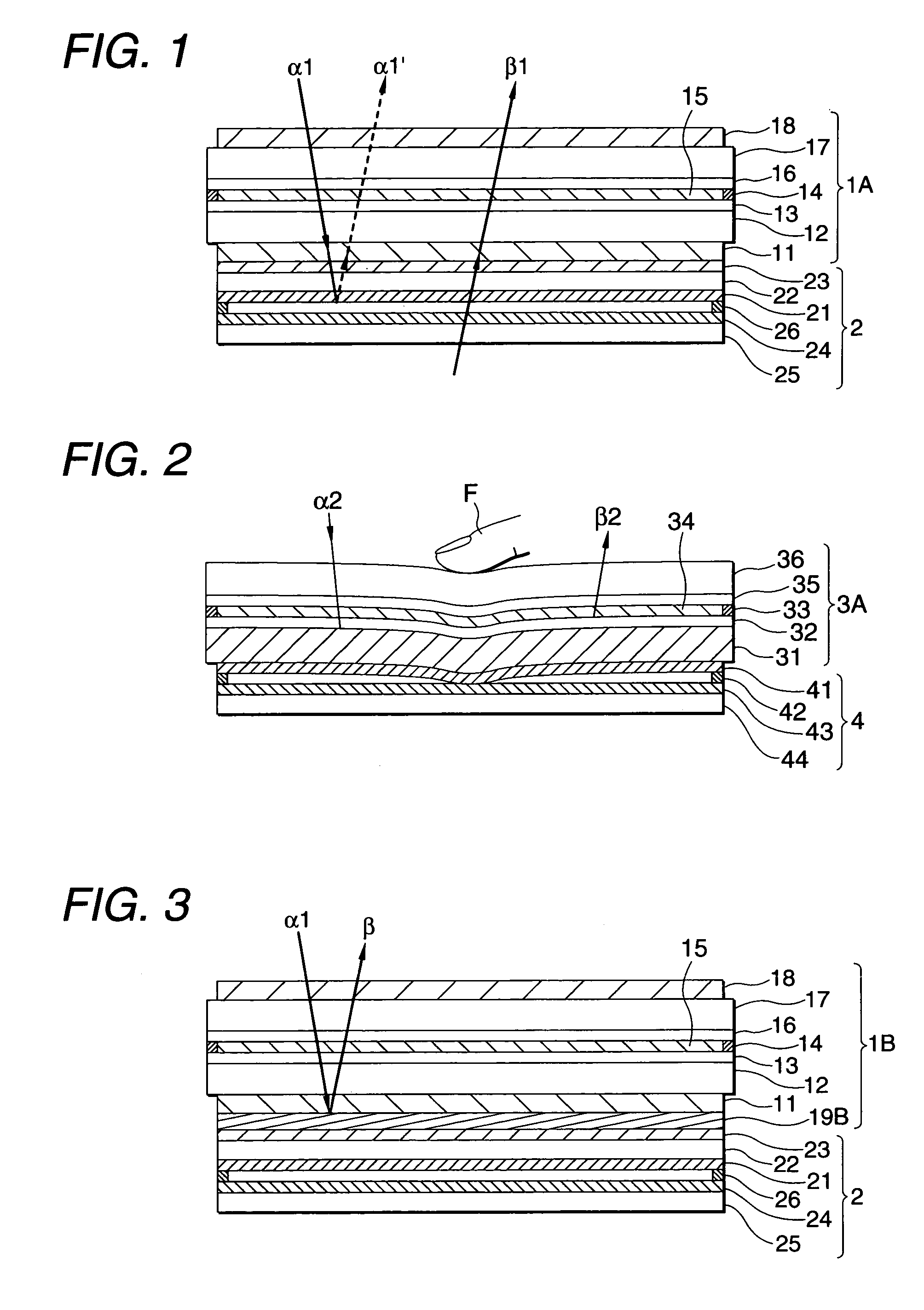Touch type liquid-crystal display device and input detecting method
a liquid crystal display and touch-type technology, applied in the direction of static indicating devices, identification means, instruments, etc., can solve the problems of deteriorating display quality, glaring light, and large external light reflection in the face, and achieve excellent forming efficiency and excellent display quality.
- Summary
- Abstract
- Description
- Claims
- Application Information
AI Technical Summary
Benefits of technology
Problems solved by technology
Method used
Image
Examples
example 1
[0043]Two planished plates were disposed and fixed into a mold through a spacer with a predetermined thickness. An alicyclic epoxy resin was injected into the mold and cured at 120° C. for 2 hours thus to form a resin plate 100 μm thick. The resin plate was cut into a predetermined size. Then, a plasma treatment was applied to the resin plate in an atmosphere of argon and a transparent electrode of indium-tin oxide (ITO) was formed on the resin plate by a sputtering method. Then, a polyvinyl alcohol solution was applied onto the resin plate with the transparent electrode by a spin coating method and a rubbing treatment was applied to the resulting dried film. Thus, a transparent resin substrate was obtained.
[0044]Then, two transparent resin substrates, one of which was obtained in the aforementioned manner and the other of which was obtained in the aforementioned manner except that the transparent electrode was further divided into two parts by etching, were disposed to be opposite ...
example 2
[0046]A transparent resin substrate was formed in the same manner as in Example 1. An ITO film was formed on one surface of the transparent resin substrate. On the other hand, a black substrate was formed as a mixture of a black pigment, and ITO films were formed on opposite surfaces of the black substrate. A rubbing treatment was applied to each of the two substrates. The two substrates were disposed to be opposite to each other through the electrode side so that the rubbing directions intersect each other perpendicularly while a gap adjusting material of spherical glass beads was disposed. Then, the two substrates were fixed by a sealing material. Incidentally, the transparent electrode in one of the two substrates was divided into two parts by etching in advance.
[0047]Then, a mixture of 10 parts by weight of trimethylpropane acrylate, 10 parts by weight of 2-hydroxyethyl acrylate, 25 parts by weight of acryl oligomer (M-1200, made by Toa Gosei Chemical Industry Co., Ltd.), 0.5 pa...
example 3
[0049]A normally white reflection type liquid-crystal display panel was obtained in the same manner as in Example 1 except that the polarizer provided on the back side opposite to the visual side was replaced by a polarizer (NPF HEG1425DU, made by Nitto Denko Corporation) having a plastic film of a surface irregularity structure and a light reflection sheet which is coated with aluminum by vapor deposition and which is bonded to the plastic film. A touch panel was provided to the reflection type liquid-crystal display panel to thereby obtain a touch type liquid-crystal display device. Hence, the light reflection sheet was positioned between the touch panel and the liquid-crystal cell.
PUM
| Property | Measurement | Unit |
|---|---|---|
| Force | aaaaa | aaaaa |
| Flexibility | aaaaa | aaaaa |
| Transmission | aaaaa | aaaaa |
Abstract
Description
Claims
Application Information
 Login to View More
Login to View More - R&D
- Intellectual Property
- Life Sciences
- Materials
- Tech Scout
- Unparalleled Data Quality
- Higher Quality Content
- 60% Fewer Hallucinations
Browse by: Latest US Patents, China's latest patents, Technical Efficacy Thesaurus, Application Domain, Technology Topic, Popular Technical Reports.
© 2025 PatSnap. All rights reserved.Legal|Privacy policy|Modern Slavery Act Transparency Statement|Sitemap|About US| Contact US: help@patsnap.com



